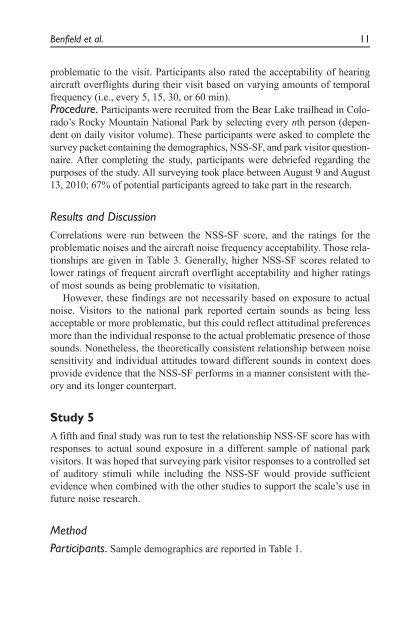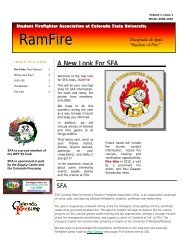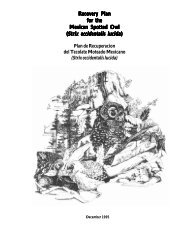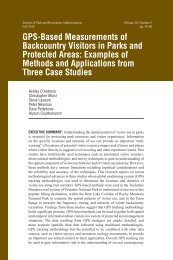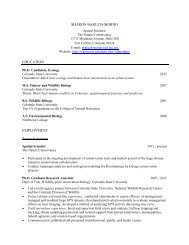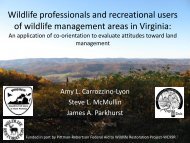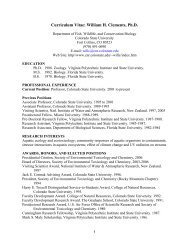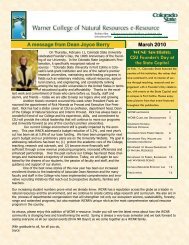Benfield, J.A., Nurse, G.A., Jakubowski, R., Gibson, A., Taff, D ...
Benfield, J.A., Nurse, G.A., Jakubowski, R., Gibson, A., Taff, D ...
Benfield, J.A., Nurse, G.A., Jakubowski, R., Gibson, A., Taff, D ...
Create successful ePaper yourself
Turn your PDF publications into a flip-book with our unique Google optimized e-Paper software.
<strong>Benfield</strong> et al. 11<br />
problematic to the visit. Participants also rated the acceptability of hearing<br />
aircraft overflights during their visit based on varying amounts of temporal<br />
frequency (i.e., every 5, 15, 30, or 60 min).<br />
Procedure. Participants were recruited from the Bear Lake trailhead in Colorado’s<br />
Rocky Mountain National Park by selecting every nth person (dependent<br />
on daily visitor volume). These participants were asked to complete the<br />
survey packet containing the demographics, NSS-SF, and park visitor questionnaire.<br />
After completing the study, participants were debriefed regarding the<br />
purposes of the study. All surveying took place between August 9 and August<br />
13, 2010; 67% of potential participants agreed to take part in the research.<br />
Results and Discussion<br />
Correlations were run between the NSS-SF score, and the ratings for the<br />
problematic noises and the aircraft noise frequency acceptability. Those relationships<br />
are given in Table 3. Generally, higher NSS-SF scores related to<br />
lower ratings of frequent aircraft overflight acceptability and higher ratings<br />
of most sounds as being problematic to visitation.<br />
However, these findings are not necessarily based on exposure to actual<br />
noise. Visitors to the national park reported certain sounds as being less<br />
acceptable or more problematic, but this could reflect attitudinal preferences<br />
more than the individual response to the actual problematic presence of those<br />
sounds. Nonetheless, the theoretically consistent relationship between noise<br />
sensitivity and individual attitudes toward different sounds in context does<br />
provide evidence that the NSS-SF performs in a manner consistent with theory<br />
and its longer counterpart.<br />
Study 5<br />
A fifth and final study was run to test the relationship NSS-SF score has with<br />
responses to actual sound exposure in a different sample of national park<br />
visitors. It was hoped that surveying park visitor responses to a controlled set<br />
of auditory stimuli while including the NSS-SF would provide sufficient<br />
evidence when combined with the other studies to support the scale’s use in<br />
future noise research.<br />
Method<br />
Participants. Sample demographics are reported in Table 1.


